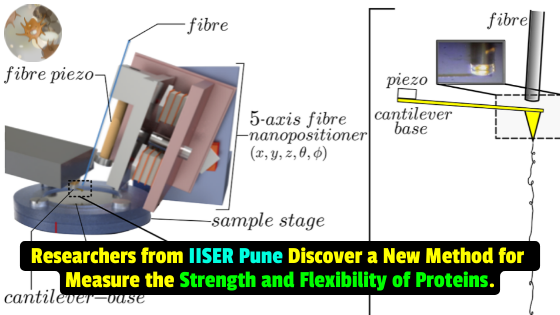Researchers at IISER in Pune have developed a method to determine the stiffness of proteins. It is possible to measure the stiffness or internal friction of a protein by measuring its bending and folding. Proteins are very necessary for maintaining the health of our bodies. Many diseases, such as diabetes and heart disease, are caused by genetic changes in proteins. It is possible to understand how proteins behave by studying the genes that people have and those that have been mutated. Scientists will be able to measure the hardness, flexibility and functions of different proteins.
- Researchers at IISER Pune have developed a method for determining protein changes. Scientists can now easily determine the stiffness of the protein chains that control the many different parts of the human body.
- The Indian Institute of Science Education and Research (IISER) in Pune has developed a device and method for determining the stiffness or flexibility of proteins.
- A protein’s stiffness or internal friction can be measured by its bending and folding.
- Many diseases, including diabetes and cardiovascular disease, are caused by genetic changes in proteins.
- Understanding how proteins behave can be gained by studying people’s genes and those mutated.
It has become easy for scientists to determine the stiffness of the protein chains that control the many different parts of the human body.
Scientists at the Indian Institute of Science Education and Research (IISER) in Pune have discovered a device and method to determine proteins’ stiffness or flexibility.
Dr. Shivprasad Patil, Surya Pratap Devpa, Shatrughan Singh Rajput, and Adarsh Kumar are also involved in the research. It is possible to measure a protein’s stiffness or internal friction by measuring its bending and folding. Proteins are extremely complex and work very minutely, but scientists at IISER have now developed a method to determine whether a protein is stiff or flexible. And many scientists have been wondering how to test whether a protein is elastic or rigid. Many scientists have tried to measure how rigid or flexible proteins are. These are very important for life. Dr. Shivprasad Patil’s group in Pune managed to measure the stiffness or flexibility of proteins a thousand times, expanding the sensitivity of an atomic force microscope (AFM) device.
Proteins are very necessary for maintaining the health of our bodies. Many diseases, such as diabetes and heart disease, are caused by genetic changes in proteins. Because many diseases, including diabetes and heart disease, are inherited, experts can predict which diseases will occur by studying the genes. It is possible to understand how proteins behave by studying the genes that people have and those that have been mutated. Because genes determine the behavior of proteins, it is important to find out how genes work. When the genes are incorrect, it leads to distortions in how proteins behave. It becomes necessary to analyze the properties of proteins to determine their changes. It is necessary to identify which protein is more rigid or flexible. A scientist couldn’t take a rigid protein molecule and compress it easily. But, now, scientists can measure the hardness, flexibility, and the different functions of different proteins, said, Dr. Shivprasad Patil.
It will be very useful for determining what changes are happening in proteins and how much they are flexible or stiff. This will help us understand how protein structure changes in response to stimuli. It will also help us understand how to create new devices for helping people with diseases. More studies are also being done in this direction, said Dr. Patil.




